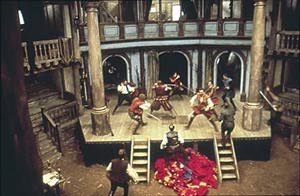This sketch is the only existing contemporary image
of an Elizabethan theatre interior, made by a visiting dutch student De
Witt during a performance at The Swan Theatre 1596, one of
London's many Bankside theatres at the time. |

Picture above show the interior of"The Rose" in
Shakepeare in Love. After filming, Judi Dench took care of the set. At
the Oscars she said during a backstage interview that she found the set
"so beautiful and so solid and so like the Rose. And I was so struck
by the set that I said to David Parfitt on the first day I was filming:'You
can't possibly break this up', so at the end of the film he gave it to
me. I've been paying for it to be restored /.../ and now I've just got
a home for it". It will be put up on the site of the Old Collins Music
Hall in London in Islington Green, and it will be used by drama students
through their training.
Usually the Elizabethan theatre interiors were a blaze of colour. As
early as 1577, Thomas White describes the playhouses as "sumptuous".
To the Elizabethans, the theatre was an image of the universe. The stage
was the earthly region where humans played out therir comedies and tragedies.
Beneath the stage lay Hell, out of which devils or ghosts would emerge
through a central trap door.
The audience ate and drank throughout performances, interrupted at will,
broke into fights and hissed and clapped the action. Reports probably highlight
the more rumbustious incidents. Audiences must have felt safe since all
sorts of people "old and young, rich and poor, master and servant,
papists and puritans" came to the Globe. [John Chamberlain
, 1624]
Those who stood below the stage payed a penny while the seated audience,
who entered through a separate entrance, paid another penny. And those
who wanted the best, cushioned seats, paid yet another penny. [Thomas Platter,
1599]
|

On this engraving from 1600 we see the Swan to the left,
the Rose [misnamed the Stare] and the now reconstructed Globe
Theatre. [Map: The Royal Library, Stockholm]
|

The Elizabethan playhouses had plain, limewashed exterior walls. Picture
above show the"The Rose" in Shakepeare in Love.
Click here to read more about present day plans
for the Rose.
|

![]()